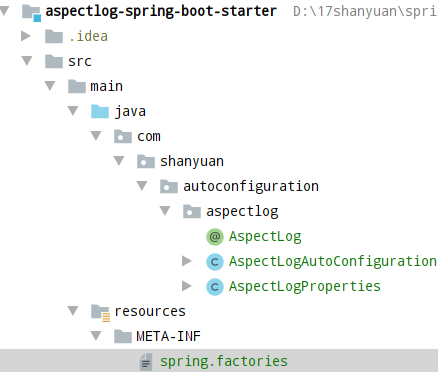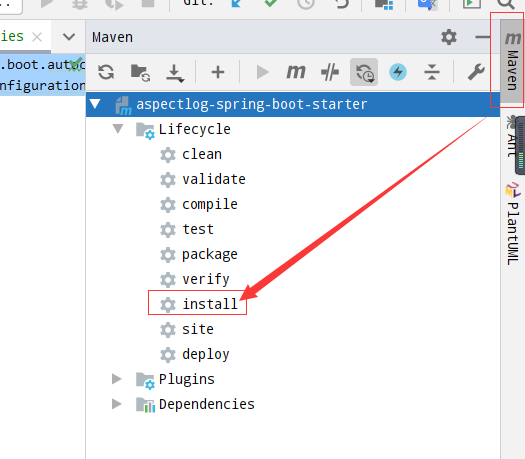仅需四步,写一个springboot starter
引言
只要你用Springboot,一定会用到各种spring-boot-starter。其实写一个spring-boot-starter
,仅需4步。下面我们就写一个starter,它将实现,在日志中打印方法执行时间。
第一步 创建maven项目
在使用spring-boot-starter,会发现,有的项目名称是 XX-spring-boot-starter,有的是
spring-boot-starter-XX,这个项目的名称有什么讲究呢?
从springboot官方文档摘录如下:
Do not start your module names with spring-boot, even if you use a different Maven groupId. We may offer official support for the thing you auto-configure in the future. As a rule of thumb, you should name a combined module after the starter.
从这段话可以看出spring-boot-starter命名的潜规则。
命名潜规则
spring-boot-starter-XX是springboot官方的starter
XX-spring-boot-starter是第三方扩展的starter
打印方法执行时间的功能,需要用到aop,咱们的项目就叫做
aspectlog-spring-boot-starter吧。
项目的pom文件如下:
<?xml version="1.0" encoding="UTF-8"?>
<project xmlns="http://maven.apache.org/POM/4.0.0"
xmlns:xsi="http://www.w3.org/2001/XMLSchema-instance"
xsi:schemaLocation="http://maven.apache.org/POM/4.0.0 http://maven.apache.org/xsd/maven-4.0.0.xsd">
<modelVersion>4.0.0</modelVersion>
<groupId>org.example</groupId>
<artifactId>aspectlog-spring-boot-starter</artifactId>
<version>1.0.2</version>
<parent>
<groupId>org.springframework.boot</groupId>
<artifactId>spring-boot-starter-parent</artifactId>
<version>2.1.15.RELEASE</version>
</parent>
<dependencies>
<dependency>
<groupId>org.springframework.boot</groupId>
<artifactId>spring-boot-autoconfigure</artifactId>
</dependency>
<dependency>
<groupId>org.springframework.boot</groupId>
<artifactId>spring-boot-starter-aop</artifactId>
</dependency>
<dependency>
<groupId>org.springframework.boot</groupId>
<artifactId>spring-boot-configuration-processor</artifactId>
<optional>true</optional>
</dependency>
</dependencies>
</project>复制代码
关于spring-boot-configuration-processor的说明,引自springBoot官方文档:
Spring Boot uses an annotation processor to collect the conditions on auto-configurations in a metadata file ( META-INF/spring-autoconfigure-metadata.properties ). If that file is present, it is used to eagerly filter auto-configurations that do not match, which will improve startup time. It is recommended to add the following dependency in a module that contains auto-configurations:
<dependency>
<groupId> org.springframework.boot </groupId>
<artifactId> spring-boot-autoconfigure-processor </artifactId>
<optional> true </optional>
</dependency>
简单说就是 写starter时,在pom中配置 spring-boot-autoconfigure-processor,
在编译时会自动收集配置类的条件,写到一个 META-INF/spring-autoconfigure-metadata.properties中。
第二步写自动配置逻辑
各种condition
| 类型 | 注解 | 说明 |
| Class Conditions 类条件注解 |
@ConditionalOnClass | 当前classpath下 有指定类才加载 |
| @ConditionalOnMissingClass | 当前classpath下 无指定类才加载 |
|
| Bean Conditions Bean条件注解 |
@ConditionalOnBean | 当期容器内有 指定bean才加载 |
| @ConditionalOnMissingBean | 当期容器内无 指定bean才加载 |
|
| Property Conditions 环境变量条件 注解(含配置文件) |
@ConditionalOnProperty | prefix 前缀 name 名称 havingValue 用于匹配配置项值 matchIfMissing 没找指定配置项时 的默认值 |
| Resource Conditions 资源条件注解 |
@ConditionalOnResource | 有指定资源才加载 |
| Web Application Conditions web条件注解 |
@ConditionalOnWebApplication | 是web才加载 |
| @ConditionalOnNotWebApplication | 不是web才加载 | |
| SpEL Expression Conditions | @ConditionalOnExpression | 符合SpEL 表达式才加载 |
本次我们就选用@ConditionalOnProperty。即配置文件中有aspectLog.enable=true,才加载我们的配置类。
下面开始写自动配置类
2.1.定义AspectLog注解,该注解用于标注需要打印执行时间的方法。
package com.shanyuan.autoconfiguration.aspectlog;
import java.lang.annotation.ElementType;
import java.lang.annotation.Retention;
import java.lang.annotation.RetentionPolicy;
import java.lang.annotation.Target;
/**
* class_name: ScheduleManage
* describe: 用于控制定时任务的开启与关闭
* 对应切面
* creat_user: wenl
* creat_time: 2018/11/10 18:45
**/
@Target(ElementType.METHOD)
@Retention(RetentionPolicy.RUNTIME)
public @interface AspectLog {
}复制代码
2.2定义配置文件对应类
package com.shanyuan.autoconfiguration.aspectlog;
import org.springframework.boot.context.properties.ConfigurationProperties;
@ConfigurationProperties("aspectLog")
public class AspectLogProperties {
private boolean enable;
public boolean isEnable() {
return enable;
}
public void setEnable(boolean enable) {
this.enable = enable;
}
}复制代码
2.3定义自动配置类
package com.shanyuan.autoconfiguration.aspectlog;
import org.aspectj.lang.ProceedingJoinPoint;
import org.aspectj.lang.annotation.Around;
import org.aspectj.lang.annotation.Aspect;
import org.slf4j.Logger;
import org.slf4j.LoggerFactory;
import org.springframework.boot.autoconfigure.condition.*;
import org.springframework.context.annotation.Configuration;
import org.springframework.context.annotation.EnableAspectJAutoProxy;
import org.springframework.core.PriorityOrdered;
@Aspect
@EnableAspectJAutoProxy(exposeProxy = true, proxyTargetClass = true)
@Configuration
@ConditionalOnProperty(prefix = "aspectLog", name = "enable",
havingValue = "true", matchIfMissing = true)
public class AspectLogAutoConfiguration implements PriorityOrdered {
protected Logger logger = LoggerFactory.getLogger(getClass());
@Around("@annotation(com.shanyuan.autoconfiguration.aspectlog.AspectLog) ")
public Object isOpen(ProceedingJoinPoint thisJoinPoint)
throws Throwable {
//执行方法名称
String taskName = thisJoinPoint.getSignature()
.toString().substring(
thisJoinPoint.getSignature()
.toString().indexOf(" "),
thisJoinPoint.getSignature().toString().indexOf("("));
taskName = taskName.trim();
long time = System.currentTimeMillis();
Object result = thisJoinPoint.proceed();
logger.info("method:{} run :{} ms", taskName,
(System.currentTimeMillis() - time));
return result;
}
@Override
public int getOrder() {
//保证事务等切面先执行
return Integer.MAX_VALUE;
}
}复制代码
配置类简要说明:
@ConditionalOnProperty(prefix = "aspectLog", name = "enable",havingValue = "true", matchIfMissing = true)
当配置文件有aspectLog.enable=true时开启,如果配置文件没有设置aspectLog.enable也开启。
第三步META-INF/spring.factories
META-INF/spring.factories是spring的工厂机制,在这个文件中定义的类,都会被自动加载。多个配置使用逗号分割,换行用/
如果有兴趣可以查看这2篇blog:
2.@Enable驱动原理(设置连接)
3.@EnableAutoConfiguration处理逻辑(设置连接)
org.springframework.boot.autoconfigure.EnableAutoConfiguration=/ com.shanyuan.autoconfiguration.aspectlog.AspectLogAutoConfiguration复制代码
第四步打包测试
这是我们最终的目录结构

在IDEA中,进行mvn intall

打包完成后,在其他项目中的pom中引入进行测试

参考资料
https://docs.spring.io/spring-boot/docs/2.1.15.RELEASE/reference/html/boot-features-developing-auto-configuration.html#boot-features-custom-starter
- 本文标签: value Features spring Proxy pom 时间 src AOP 编译 cat XML ACE 目录 EnableAutoConfiguration maven 代码 example IO web tar HTML http springboot tab IDE schema bean apache https App ask Spring Boot classpath UI dependencies Property java CTO core id 测试 配置
- 版权声明: 本文为互联网转载文章,出处已在文章中说明(部分除外)。如果侵权,请联系本站长删除,谢谢。
- 本文海报: 生成海报一 生成海报二











![[HBLOG]公众号](https://www.liuhaihua.cn/img/qrcode_gzh.jpg)

